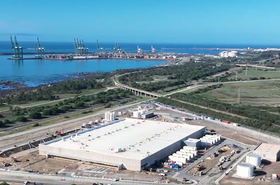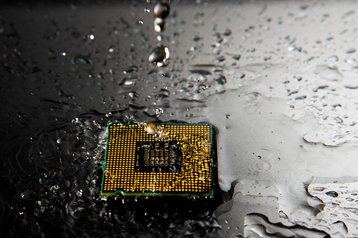A new wave of change, fueled by the rise of generative AI and accelerated workloads, is rewriting long-held design standards and practices across data centers. As compute densities surge and rack-level thermal loads skyrocket, traditional cooling methods are under increasing pressure to evolve. The age of densification isn’t on the horizon, it’s already here.
Simultaneously, mounting scrutiny over energy usage and carbon emissions is forcing operators and suppliers to rethink their roles and approaches. Success in this new era will depend on the ability to collaborate, innovate, and engineer solutions holistically – from power input to thermal management.
In this episode of DCD>Talks, Maurizio Frizziero, director of cooling innovation and strategy at Schneider Electric explores how the company is approaching these key industry challenges. A long-time innovator in the data center space, Schneider is taking a bold stance: cooling is no longer a product, it’s an architecture.
Rethinking cooling in the AI era
Frizziero describes the crux of the current trajectory of data center cooling demands: “AI and densification are real game changers. They are challenging all of us, not just vendors, but the entire ecosystem.”
The pressures on modern infrastructure are clear: higher compute densities lead to significant increases in heat output, straining both the energy efficiency and effectiveness of traditional air cooling strategies. In Frizziero’s view, these challenges can’t be solved by technology alone. Instead, they require a shift in mindset, from siloed product deployment to full-stack, end-to-end design integration.
“Liquid cooling is not a product. It’s an architecture,” he explains. “It’s a combination of different technologies that must be integrated together.” At Schneider Electric, this translates into a strategy that spans the entire power and cooling chain from the grid to the chip, and from the chip to the chiller.
It’s an ambitious approach that aligns with the demands of modern data centers. As workloads grow more intense and hardware becomes more compact, ensuring that cooling systems can scale alongside compute is critical – not only for performance, but for energy use and carbon reduction.
Owning the entire stack
One of the ways Schneider is responding to this key challenge is via portfolio expansion. The company is targeting capabilities that enhance its architectural vision.
“The acquisitions we’ve made in liquid cooling are more about knowledge than products,” says Frizziero. A recent example is Motivair, whose integration into the Schneider portfolio enhances the company’s ability to engineer and deploy tightly integrated cooling solutions across a wide range of densities and deployments.
“These are know-how acquisitions,” continues Frizziero. “They allow us to close gaps in the end-to-end chain and give us deeper insight into what’s happening, and what will happen, in the data center business.”
This approach is aimed at providing customers with a more complete offering, designed with optimization in mind. “It’s not just about suggesting one portion of the solution,” says Frizziero. “It’s about looking at the overall picture – how to minimize energy consumption and maximize the effectiveness of game-time decisions.
“Sometimes, it’s not about having the most efficient unit. It’s about how each unit works within the chain – where you can offset inefficiencies and where you can gain synergy.”
Density as a third dimension
One of the most significant variables complicating modern cooling deployments is the emergence of extreme density variability. Traditional data center design was relatively uniform, with most facilities centered around average rack densities of 10-15kW. But the AI revolution has drastically altered this standard.
“We are moving from a bi-dimensional set of design options to a three-dimensional one,” explains Frizziero. “Density is the new axis.”
That third dimension introduces enormous variability, from low-density racks to clusters consuming over 150kW per rack, and this has a ripple effect on everything from site planning to supply chain logistics. Design approaches, commissioning timelines, and operational reliability must now accommodate an array of different possibilities, many of which change in real time.
This makes an integrated, holistic view even more important. “Fragmented supply chains and complex deployments become exponentially harder to manage when density isn’t static,” says Frizziero. “You need a partner that sees the whole landscape – not just the unit they sell.”
Staying connected
When cooling solutions are disconnected from broader energy and design strategies, it can lead to an ineffective setup overall. “The biggest consequence is failing to dissipate heat correctly, and failing to use the energy available to you,” says Frizziero.
With energy availability becoming increasingly constrained in many regions, including recent grid pressure events in Spain and Portugal, operators can no longer afford to treat cooling as an entirely separate factor. Cooling decisions now affect not only performance and OPEX (operating expenses), but also long-term efficiency and scalability.
“We are no longer just talking about cost,” continues Frizziero. “We’re talking about whether your data center can operate effectively, and whether it can evolve.” Without coordination between power delivery, compute density, and thermal management, energy optimization becomes impossible.
That’s where Schneider’s integrated approach proves vital. By managing the cooling chain from chip to chiller, and connecting it to upstream power strategies, the company aims to maximize energy use while minimizing waste. The result is a facility that can grow with confidence, even in the face of an uncertain, challenging future.
Innovation and co-innovation
While Schneider is addressing today’s demand head-on, Frizziero is just as focused on the road ahead. The company’s approach to innovation is built around three pillars: serving current demand, investing in future technologies, and co-creating solutions with upstream and downstream partners.
“We can’t just respond to today’s market – we have to anticipate tomorrow’s needs,” says Frizziero. In the near term, that means expanding capabilities in single-phase, direct-to-chip liquid cooling. But longer-term, it involves exploring next-gen technologies and alternative cooling fluids that could address the thermal challenges of tomorrow’s workloads.
“Single-phase is today’s answer, but it may not be the long-term solution,” he adds. Schneider is already evaluating new cooling approaches that can serve future AI architectures and hardware designs.
Perhaps most notably, the company is engaging in what Frizziero calls ‘co-innovation’. By working closely with server manufacturers like Nvidia and key end users, Schneider is aligning its research and development (R&D) efforts with real-world demands, creating a cycle that benefits the entire chain of demand.
“Innovation is no longer something a vendor does alone,” explains Frizziero. “It has to happen upstream with the server manufacturers, and downstream with the customers. It’s a cooperative game now.”
As the conversation comes to an end, Frizziero returns to a central theme: partnership. In a fast paced, ever-changing landscape, one thing is certain: addressing rising demands and taking on future challenges will take a collaborative effort with a holistic, end-to-end view. It’s this stance that will enable operators and suppliers alike to scale up for the new age of high-density cooling.
To hear more about how Schneider Electric is innovating cooling systems to meet the demand of today and tomorrow, listen to the full DCD>Talks episode with Maurizio Frizziero, here.
More from Schneider Electric

Sponsored
Why the changes and challenges brought on by the rapid rise of AI can’t be met with yesterday’s cooling methods

Sponsored
Reduce total cost of ownership in data centers with Galaxy VXL three-phase UPS and EcoCare services
How to balance your Capex and Opex by optimizing your investment and minimizing ongoing expenses

Start Campus and Schneider Electric partner to deliver 26MW data center in Sines, Portugal
First stage of 1.2GW campus is online now
Read the orginal article: https://www.datacenterdynamics.com/en/marketwatch/cooling-with-confidence/



